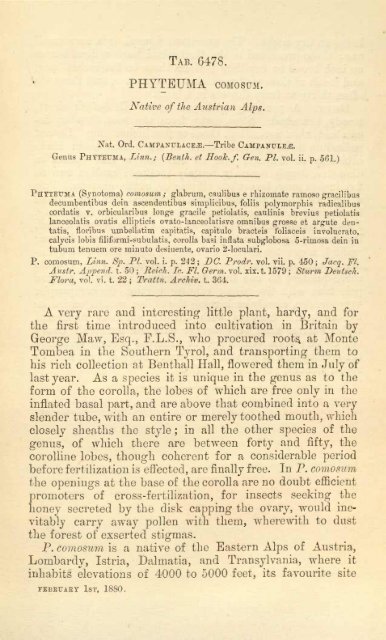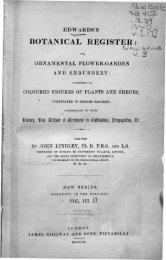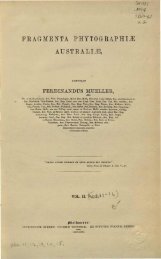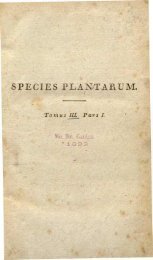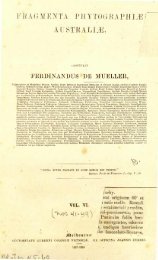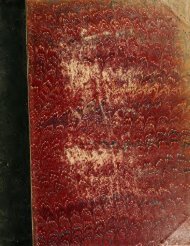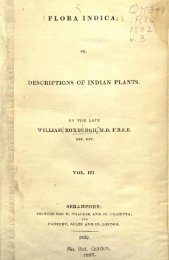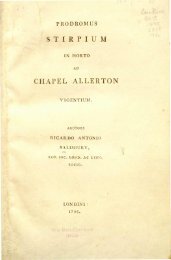Botanical Magazine 106 - 1880.pdf - hibiscus.org
Botanical Magazine 106 - 1880.pdf - hibiscus.org
Botanical Magazine 106 - 1880.pdf - hibiscus.org
Create successful ePaper yourself
Turn your PDF publications into a flip-book with our unique Google optimized e-Paper software.
TAB. 6478.<br />
PHYTEUMA COMOSüM.<br />
Native of the Austrian Alps.<br />
Nat. Ord. CAMPANFLACES.•Tribe CAMPANULES.<br />
Genus PHYTEUMA, Linn.; {Benth. et Hook. f. Gen. PI. vol. ii. p. 561.)<br />
PHTTETJMA (Synotoma) comosum; glabrum, caulibus e rhizomate ramoso grácil i bus<br />
decuinbentibus dein, ascendentibus simplicibus, foliis polymorphis radicalibus<br />
cordatis v. orbicularibus longe gracile petiolatis, caulinis brevius petiolatis<br />
lanceolatis ovatis ellipticis ovato-lanceolatisve omnibus grosse et argute deii-<br />
tatis, floribus umbellatim capitatis, capitulo bracteis t'oliaceis involucrato,<br />
calycis lobis filiformi-subulatis, corolla basi inflata subglobosa 5-rimosa dein in<br />
tmbum tenuem ore minuto desinente, ovario 2-loculari.<br />
P. comosum, Linn. Sp. PL vol. i. p. 242; DC. Prodr. vol. vii. p. 450; Jacq. FL<br />
Austr. Append, t. 50 ; Reich. In. Fl. Germ. vol. xix. 1.1579 ; Sturm Deutsch.<br />
Flora, vol. vi. t. 22 ; Trattn. Archiv, t. 364.<br />
A very rare and interesting little plant, hardy, and for<br />
the first time introduced into cultivation in Britain by<br />
Ge<strong>org</strong>e Maw, Esq., F.L.S., who procured roots, at Monte<br />
Tombea in the Southern Tyrol, and transporting them to<br />
his rich collection at Benthall Hall, flowered them in July of<br />
last year. As a species it is unique in the genus as to the<br />
form of the corolla, the lobes of which are free only in the<br />
inflated basal part, and are above that combined into a very<br />
slender tube, with an entire or merely toothed mouth, which<br />
closely sheaths the style; in all the other species of the<br />
genus, of which there are between forty and fifty, the<br />
corolline lobes, though coherent for a considerable period<br />
before fertilization is effected, are finally free. In P. comosum<br />
the openings at the base of the corolla are no doubt efficient<br />
promoters of cross-fertilization, for insects seeking the<br />
honey secreted by the disk capping the ovary, would ine-<br />
vitably carry away pollen with them, wherewith to dust<br />
the forest of exserted stigmas.<br />
P. comosum is a native of the Eastern Alps of Austria,<br />
Lombardy, Istria, Dalmatia, and Transylvania, where it<br />
inhabits elevations of 4000 to 5000 feet, its favourite site<br />
FEBBUABY 1ST, 1880.


